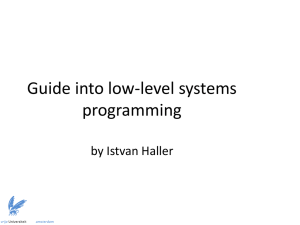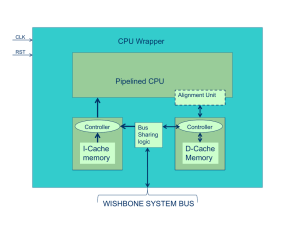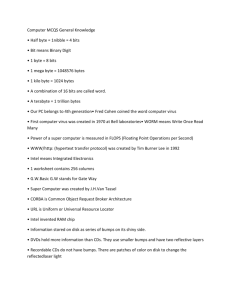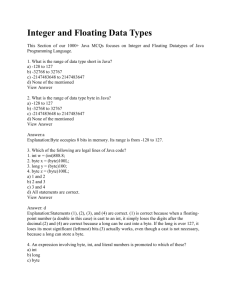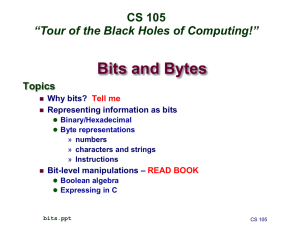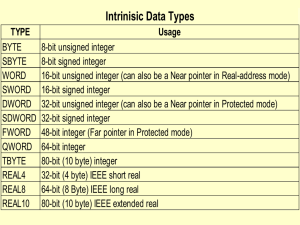whitepaper
advertisement
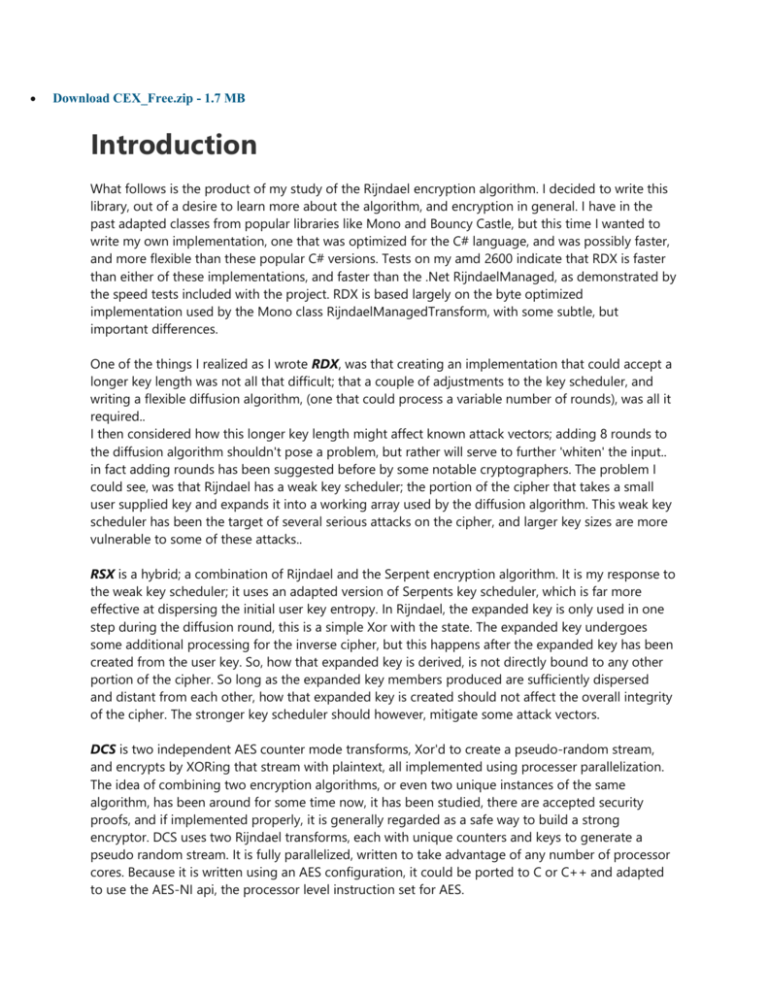
Download CEX_Free.zip - 1.7 MB
Introduction
What follows is the product of my study of the Rijndael encryption algorithm. I decided to write this
library, out of a desire to learn more about the algorithm, and encryption in general. I have in the
past adapted classes from popular libraries like Mono and Bouncy Castle, but this time I wanted to
write my own implementation, one that was optimized for the C# language, and was possibly faster,
and more flexible than these popular C# versions. Tests on my amd 2600 indicate that RDX is faster
than either of these implementations, and faster than the .Net RijndaelManaged, as demonstrated by
the speed tests included with the project. RDX is based largely on the byte optimized
implementation used by the Mono class RijndaelManagedTransform, with some subtle, but
important differences.
One of the things I realized as I wrote RDX, was that creating an implementation that could accept a
longer key length was not all that difficult; that a couple of adjustments to the key scheduler, and
writing a flexible diffusion algorithm, (one that could process a variable number of rounds), was all it
required..
I then considered how this longer key length might affect known attack vectors; adding 8 rounds to
the diffusion algorithm shouldn't pose a problem, but rather will serve to further 'whiten' the input..
in fact adding rounds has been suggested before by some notable cryptographers. The problem I
could see, was that Rijndael has a weak key scheduler; the portion of the cipher that takes a small
user supplied key and expands it into a working array used by the diffusion algorithm. This weak key
scheduler has been the target of several serious attacks on the cipher, and larger key sizes are more
vulnerable to some of these attacks..
RSX is a hybrid; a combination of Rijndael and the Serpent encryption algorithm. It is my response to
the weak key scheduler; it uses an adapted version of Serpents key scheduler, which is far more
effective at dispersing the initial user key entropy. In Rijndael, the expanded key is only used in one
step during the diffusion round, this is a simple Xor with the state. The expanded key undergoes
some additional processing for the inverse cipher, but this happens after the expanded key has been
created from the user key. So, how that expanded key is derived, is not directly bound to any other
portion of the cipher. So long as the expanded key members produced are sufficiently dispersed
and distant from each other, how that expanded key is created should not affect the overall integrity
of the cipher. The stronger key scheduler should however, mitigate some attack vectors.
DCS is two independent AES counter mode transforms, Xor'd to create a pseudo-random stream,
and encrypts by XORing that stream with plaintext, all implemented using processer parallelization.
The idea of combining two encryption algorithms, or even two unique instances of the same
algorithm, has been around for some time now, it has been studied, there are accepted security
proofs, and if implemented properly, it is generally regarded as a safe way to build a strong
encryptor. DCS uses two Rijndael transforms, each with unique counters and keys to generate a
pseudo random stream. It is fully parallelized, written to take advantage of any number of processor
cores. Because it is written using an AES configuration, it could be ported to C or C++ and adapted
to use the AES-NI api, the processor level instruction set for AES.
RDX up to a 256 bit key is equivalent to any other valid implementation of Rijndael, and I provide a
number of standard tests to demonstrate its compliance. The modes are tested for equivalency as
well, including the parallelized CTR mode, which along with the implementations portability, small
size, speed, and simplicity, are all advantages to using this library.
I hope to expand this library in the future, as I continue my exploration of encryption technologies,
and I welcome input from cryptographers and programmers. If you have a comment or concern, I'd
be glad to hear from you.
Before downloading the source files, it is your responsibility to check if these extended key lengths
(512 and 768) are legal in your country. If you use this code, please do so responsibly and in
accordance to law in your region.
For a full featured implementation of these algorithms, including key management, authentication
controls, anti-tampering measures, encrypted assets, a very cool interface, and many more features;
check out the version on my website: CEX on vtdev.com.
RDX
RDX is an implementation of the Rijndael encryption algorithm, the same one used in the AES
standard. What I have done is to extend Rijndael so that it now accepts the longer key length (512
bits). The extended key length provides more security against attacks that attempt to brute force the
key, and also adds eight more rounds of diffusion.
The increased number of rounds brings the total from 14 rounds with a 256 bit key, to 22 rounds
with the 512 bit key size. These added passes through the diffusion algorithm further disperse the
input through row and column transpositions, and XOR’s with a longer expanded key array.
The Key Scheduler:
The key scheduler is where this version departs from the standard. The maximum key length has
been extended to allow for a 512 bit (64 byte) key size. Creating this extension requires two
conditions; the diffusion rounds should be written as a loop, (to accommodate the additional rounds
of mixing), and the key scheduler code must be written in a way that it can process the user key into
a larger working key, (the integer array that the diffusion algorithm uses as part of the input
transformation process). The key scheduler I have used here is based on the Mono
library implementation used in the class RijndaelManagedTransform.cs.
private void ExpandKey(byte[] Key, bool Encryption)
{
int pos = 0;
// block and key in 32 bit words
Nb = this.BlockSize / 4;
Nk = Key.Length / 4;
// rounds calculation
if (Nk == 16)
Nr = 22;
else if (Nb == 8 || Nk == 8)
Nr = 14;
else if (Nk == 6)
Nr = 12;
else
Nr = 10;
// setup expanded key
int keySize = Nb * (Nr + 1);
_exKey = new UInt32[keySize];
// add bytes to beginning of working key array
for (int i = 0; i < Nk; i++)
{
UInt32 value = ((UInt32)Key[pos++] << 24);
value |= ((UInt32)Key[pos++] << 16);
value |= ((UInt32)Key[pos++] << 8);
value |= ((UInt32)Key[pos++]);
_exKey[i] = value;
}
// build the remaining round keys
for (int i = Nk; i < keySize; i++)
{
UInt32 temp = _exKey[i - 1];
// if it is a 512 bit key, maintain step 8 interval for
// additional processing steps, equal to a 256 key distribution
if (Nk > 8)
{
if (i % Nk == 0 || i % Nk == 8)
{
// round the key
UInt32 rot = (UInt32)((temp << 8) | ((temp >> 24) & 0xff));
// subbyte step
temp = SubByte(rot) ^ Rcon[i / Nk];
}
// step ik + 4
else if ((i % Nk) == 4 || (i % Nk) == 12)
{
temp = SubByte(temp);
}
}
else
{
if (i % Nk == 0)
{
// round the key
UInt32 rot = (UInt32)((temp << 8) | ((temp >> 24) & 0xff));
// subbyte step
temp = SubByte(rot) ^ Rcon[i / Nk];
}
// step ik + 4
else if (Nk > 6 && (i % Nk) == 4)
{
temp = SubByte(temp);
}
}
// w[i-Nk] ^ w[i]
_exKey[i] = (UInt32)_exKey[i - Nk] ^ temp;
}
// inverse cipher
if (!Encryption)
{
// reverse key
for (int i = 0, k = keySize - Nb; i < k; i += Nb, k -= Nb)
{
for (int j = 0; j < Nb; j++)
{
UInt32 temp = _exKey[i + j];
_exKey[i + j] = _exKey[k + j];
_exKey[k + j] = temp;
}
}
// sbox inversion
for (int i = Nb; i < keySize - Nb; i++)
{
_exKey[i] = IT0[SBox[(_exKey[i] >> 24)]] ^
IT1[SBox[(byte)(_exKey[i] >> 16)]] ^
IT2[SBox[(byte)(_exKey[i] >> 8)]] ^
IT3[SBox[(byte)_exKey[i]]];
}
}
this.IsInitialized = true;
}
The first thing to note is the rounds calculation; I have added an additional clause of
if (Nk == 16) Nr = 22
Nk is equal to the number of 32 bit words in the user supplied key
Nr is the number of rounds as a function of Nk and Nb
Nb is the size of the state in 32 bit words, in this implementation Nb is either 4 (16 byte block), or 8
(32 byte block).
The number of round keys created is a function of Nb (Nr + 1), which is the number of rounds
plus one, multiplied by the number of 32 bit words in the block size. A 512 bit user key with a 16
byte block size will generate 92 working keys, or 184 working keys with a 32 byte block. A 256 bit key
generates 60 or 120 working keys. A better dispersion ratio of user key to expanded key size is
achieved with the larger 512 bit key; bytes(32 byte key: 32/240 and 32/480, 64 byte key: 64/368 and
64/736).
The next step is adding the user key to the beginning of the working key, shifting the user key bytes
into the working key, which adds the first eight integers with a 256 bit key, or 16 integers with a 512
bit key.
We then create the additional working keys. The working key, exKey[i], is equal to the XOR of the
previous word, exKey[i-1], and the word Nk positions earlier, exKey[i-Nk].
With a 256 bit key; every Nk interval, an additional step is added that first rounds the key, then
processes it with SubByte(), (SBox lookup applied to each byte), then Xors this with a round constant
from the Rcon table. This extra step happens on a modulus of i % Nk, with a 256 bit key that is step
8, or every 8 passes through the loop.
The expansion routine for a 256 bit key uses some additional processing; if i % Nk yields a remainder
of 4, then SubByte() is applied to exKey[i-1] prior to the Xor with exKey[i-Nk]. The designers
implemented this to further disperse the larger 256 bit key.
With a 512 bit key; Nk = 16, which would double the interval between these additional dispersal
steps, and create a weaker expanded key. I have compensated for this by maintaining the same
intervals in the dispersion pattern; just as with a 256 bit key every 8 keys, the Rcon ^ SubByte step
executes, with the SubByte step at the same alternating offset 4 interval.
If the transform is for decryption then a routine performs the additional key reversal and SBox
inversion, required by the inverse cipher.
As I mentioned this implementation of the key expansion routine is based on the C# Mono version,
the only real change I have made was to the rounds calculation, adding the additional 8 rounds of
diffusion when a 512 bit key is used, other than that the key expansion routine is exactly the same.
Diffusion Algorithm:
When writing this method I first took a look at a number of implementations in various languages, to
try and get a better idea of the different ways in which the diffusion algorithm could be expressed
programmatically; and how that related to the strengths and weaknesses of the C# language,
(though these classes could very easily be ported to Java or C).
The Bouncy Castle version processes a multi-dimensional array of unsigned integers rather than
bytes, (which is more in keeping with the specification outline). It converts the bytes to integers and
back again after the transformation.
The Mono version processes bytes, using method level integers to store the transposition sums. My
first thought was to avoid a multi-dimensional array, as these are slow in almost every language. I did
some speed comparisons, and the two versions were close to equal, but there were some things that
could be done to speed up processing in the Mono version, and because we are using a variable key
size, we need the diffusion rounds to run in a loop.
To get some idea of how different the methods are, look at the Tests\CompareEngines.cs speed test,
the diffusion algorithm from Bouncy Castle, Mono, and RDX are all there, and they are all quite
different, (and RDX is fastest). This is what the 16 byte block version of the encryption algorithm
looks like in RDX:
private void Encrypt16(byte[] Input, byte[] Output)
{
int ct = 0;
UInt32 R0, R1, R2, R3, C0, C1, C2, C3;
// Round 0
R0 = (((UInt32)Input[0] << 24) | ((UInt32)Input[1] << 16) | ((UInt32)Input[2] << 8) | (UInt32)Input[3]) ^ _exKey[ct++];
R1 = (((UInt32)Input[4] << 24) | ((UInt32)Input[5] << 16) | ((UInt32)Input[6] << 8) | (UInt32)Input[7]) ^ _exKey[ct++];
R2 = (((UInt32)Input[8] << 24) | ((UInt32)Input[9] << 16) | ((UInt32)Input[10] << 8) | (UInt32)Input[11]) ^ _exKey[ct++];
R3 = (((UInt32)Input[12] << 24) | ((UInt32)Input[13] << 16) | ((UInt32)Input[14] << 8) | (UInt32)Input[15]) ^ _exKey[ct++];
// Round 1
C0 = T0[R0 >> 24] ^ T1[(byte)(R1 >> 16)] ^ T2[(byte)(R2 >> 8)] ^ T3[(byte)R3] ^ _exKey[ct++];
C1 = T0[R1 >> 24] ^ T1[(byte)(R2 >> 16)] ^ T2[(byte)(R3 >> 8)] ^ T3[(byte)R0] ^ _exKey[ct++];
C2 = T0[R2 >> 24] ^ T1[(byte)(R3 >> 16)] ^ T2[(byte)(R0 >> 8)] ^ T3[(byte)R1] ^ _exKey[ct++];
C3 = T0[R3 >> 24] ^ T1[(byte)(R0 >> 16)] ^ T2[(byte)(R1 >> 8)] ^ T3[(byte)R2] ^ _exKey[ct++];
while (ct < Nr * Nb)
{
R0 = T0[C0 >> 24] ^ T1[(byte)(C1 >> 16)] ^ T2[(byte)(C2 >> 8)] ^ T3[(byte)C3] ^ _exKey[ct++];
R1 = T0[C1 >> 24] ^ T1[(byte)(C2 >> 16)] ^ T2[(byte)(C3 >> 8)] ^ T3[(byte)C0] ^ _exKey[ct++];
R2 = T0[C2 >> 24] ^ T1[(byte)(C3 >> 16)] ^ T2[(byte)(C0 >> 8)] ^ T3[(byte)C1] ^ _exKey[ct++];
R3 = T0[C3 >> 24] ^ T1[(byte)(C0 >> 16)] ^ T2[(byte)(C1 >> 8)] ^ T3[(byte)C2] ^ _exKey[ct++];
C0 = T0[R0 >> 24] ^ T1[(byte)(R1 >> 16)] ^ T2[(byte)(R2 >> 8)] ^ T3[(byte)R3] ^ _exKey[ct++];
C1 = T0[R1 >> 24] ^ T1[(byte)(R2 >> 16)] ^ T2[(byte)(R3 >> 8)] ^ T3[(byte)R0] ^ _exKey[ct++];
C2 = T0[R2 >> 24] ^ T1[(byte)(R3 >> 16)] ^ T2[(byte)(R0 >> 8)] ^ T3[(byte)R1] ^ _exKey[ct++];
C3 = T0[R3 >> 24] ^ T1[(byte)(R0 >> 16)] ^ T2[(byte)(R1 >> 8)] ^ T3[(byte)R2] ^ _exKey[ct++];
}
// Final Round
Output[0] = (byte)(SBox[C0 >> 24] ^ (byte)(_exKey[ct] >> 24));
Output[1] = (byte)(SBox[(byte)(C1 >> 16)] ^ (byte)(_exKey[ct] >> 16));
Output[2] = (byte)(SBox[(byte)(C2 >> 8)] ^ (byte)(_exKey[ct] >> 8));
Output[3] = (byte)(SBox[(byte)C3] ^ (byte)_exKey[ct++]);
Output[4] = (byte)(SBox[C1 >> 24] ^ (byte)(_exKey[ct] >> 24));
Output[5] = (byte)(SBox[(byte)(C2 >> 16)] ^ (byte)(_exKey[ct] >> 16));
Output[6] = (byte)(SBox[(byte)(C3 >> 8)] ^ (byte)(_exKey[ct] >> 8));
Output[7] = (byte)(SBox[(byte)C0] ^ (byte)_exKey[ct++]);
Output[8] = (byte)(SBox[C2 >> 24] ^ (byte)(_exKey[ct] >> 24));
Output[9] = (byte)(SBox[(byte)(C3 >> 16)] ^ (byte)(_exKey[ct] >> 16));
Output[10] = (byte)(SBox[(byte)(C0 >> 8)] ^ (byte)(_exKey[ct] >> 8));
Output[11] = (byte)(SBox[(byte)C1] ^ (byte)_exKey[ct++]);
Output[12] = (byte)(SBox[C3 >> 24] ^ (byte)(_exKey[ct] >> 24));
Output[13] = (byte)(SBox[(byte)(C0 >> 16)] ^ (byte)(_exKey[ct] >> 16));
Output[14] = (byte)(SBox[(byte)(C1 >> 8)] ^ (byte)(_exKey[ct] >> 8));
Output[15] = (byte)(SBox[(byte)C2] ^ (byte)_exKey[ct]);
}
This is based on the Mono version with some important differences; in the Mono version, the rounds
are laid out sequentially with the key index as a series of fixed integers, and uses if ei > len clauses
to control the number of rounds processed based on the extended key size. In this version, a single
incrementing integer ct is used as the the key index, and the rounds are processed in a while loop
based on the formula ct < Nr * Nb. Using a single incrementing counter, and eliminating the rounds
clauses increases the speed significantly.
As you can see this version uses the byte oriented approach and is optimized by combining the
SubBytes and ShiftRows steps with the MixColumns step by transforming them into a sequence
of table lookups using the byte values as table indices. This requires four 256 member pre-calculated
lookup tables to perform the byte multiplication. The AddRoundKey step is then performed with
an additional Xor of the expanded key, and a round is completed with just with 16 table lookups, and
16 Xor operations.
The 32 byte block size also conforms to a standard Rijndael configuration, by shifting the lookup
value on the second, third and fourth row by 1 byte, 3 bytes and 4 bytes respectively. This is done to
keep columns linearly independent.
private void Encrypt32(byte[] Input, byte[] Output)
{
int ct = 0;
UInt32 R0, R1, R2, R3, R4, R5, R6, R7, C0, C1, C2, C3, C4, C5, C6, C7;
// Round 0
R0 = (((UInt32)Input[0] << 24) | ((UInt32)Input[1] << 16) | ((UInt32)Input[2] << 8) | (UInt32)Input[3]) ^ _exKey[ct++];
R1 = (((UInt32)Input[4] << 24) | ((UInt32)Input[5] << 16) | ((UInt32)Input[6] << 8) | (UInt32)Input[7]) ^ _exKey[ct++];
R2 = (((UInt32)Input[8] << 24) | ((UInt32)Input[9] << 16) | ((UInt32)Input[10] << 8) | (UInt32)Input[11]) ^ _exKey[ct++];
R3 = (((UInt32)Input[12] << 24) | ((UInt32)Input[13] << 16) | ((UInt32)Input[14] << 8) | (UInt32)Input[15]) ^ _exKey[ct++];
R4 = (((UInt32)Input[16] << 24) | ((UInt32)Input[17] << 16) | ((UInt32)Input[18] << 8) | (UInt32)Input[19]) ^ _exKey[ct++];
R5 = (((UInt32)Input[20] << 24) | ((UInt32)Input[21] << 16) | ((UInt32)Input[22] << 8) | (UInt32)Input[23]) ^ _exKey[ct++];
R6 = (((UInt32)Input[24] << 24) | ((UInt32)Input[25] << 16) | ((UInt32)Input[26] << 8) | (UInt32)Input[27]) ^ _exKey[ct++];
R7 = (((UInt32)Input[28] << 24) | ((UInt32)Input[29] << 16) | ((UInt32)Input[30] << 8) | (UInt32)Input[31]) ^ _exKey[ct++];
// Round 1
C0 = T0[R0 >> 24] ^ T1[(byte)(R1 >> 16)] ^ T2[(byte)(R3 >> 8)] ^ T3[(byte)R4] ^ _exKey[ct++];
C1 = T0[R1 >> 24] ^ T1[(byte)(R2 >> 16)] ^ T2[(byte)(R4 >> 8)] ^ T3[(byte)R5] ^ _exKey[ct++];
C2 = T0[R2 >> 24] ^ T1[(byte)(R3 >> 16)] ^ T2[(byte)(R5 >> 8)] ^ T3[(byte)R6] ^ _exKey[ct++];
C3 = T0[R3 >> 24] ^ T1[(byte)(R4 >> 16)] ^ T2[(byte)(R6 >> 8)] ^ T3[(byte)R7] ^ _exKey[ct++];
C4 = T0[R4 >> 24] ^ T1[(byte)(R5 >> 16)] ^ T2[(byte)(R7 >> 8)] ^ T3[(byte)R0] ^ _exKey[ct++];
C5 = T0[R5 >> 24] ^ T1[(byte)(R6 >> 16)] ^ T2[(byte)(R0 >> 8)] ^ T3[(byte)R1] ^ _exKey[ct++];
C6 = T0[R6 >> 24] ^ T1[(byte)(R7 >> 16)] ^ T2[(byte)(R1 >> 8)] ^ T3[(byte)R2] ^ _exKey[ct++];
C7 = T0[R7 >> 24] ^ T1[(byte)(R0 >> 16)] ^ T2[(byte)(R2 >> 8)] ^ T3[(byte)R3] ^ _exKey[ct++];
// rounds loop
while (ct < Nr * Nb)
{
R0 = T0[C0 >> 24] ^ T1[(byte)(C1 >> 16)] ^ T2[(byte)(C3 >> 8)] ^ T3[(byte)C4] ^ _exKey[ct++];
R1 = T0[C1 >> 24] ^ T1[(byte)(C2 >> 16)] ^ T2[(byte)(C4 >> 8)] ^ T3[(byte)C5] ^ _exKey[ct++];
R2 = T0[C2 >> 24] ^ T1[(byte)(C3 >> 16)] ^ T2[(byte)(C5 >> 8)] ^ T3[(byte)C6] ^ _exKey[ct++];
R3 = T0[C3 >> 24] ^ T1[(byte)(C4 >> 16)] ^ T2[(byte)(C6 >> 8)] ^ T3[(byte)C7] ^ _exKey[ct++];
R4 = T0[C4 >> 24] ^ T1[(byte)(C5 >> 16)] ^ T2[(byte)(C7 >> 8)] ^ T3[(byte)C0] ^ _exKey[ct++];
R5 = T0[C5 >> 24] ^ T1[(byte)(C6 >> 16)] ^ T2[(byte)(C0 >> 8)] ^ T3[(byte)C1] ^ _exKey[ct++];
R6 = T0[C6 >> 24] ^ T1[(byte)(C7 >> 16)] ^ T2[(byte)(C1 >> 8)] ^ T3[(byte)C2] ^ _exKey[ct++];
R7 = T0[C7 >> 24] ^ T1[(byte)(C0 >> 16)] ^ T2[(byte)(C2 >> 8)] ^ T3[(byte)C3] ^ _exKey[ct++];
C0 = T0[R0 >> 24] ^ T1[(byte)(R1 >> 16)] ^ T2[(byte)(R3 >> 8)] ^ T3[(byte)R4] ^ _exKey[ct++];
C1 = T0[R1 >> 24] ^ T1[(byte)(R2 >> 16)] ^ T2[(byte)(R4 >> 8)] ^ T3[(byte)R5] ^ _exKey[ct++];
C2 = T0[R2 >> 24] ^ T1[(byte)(R3 >> 16)] ^ T2[(byte)(R5 >> 8)] ^ T3[(byte)R6] ^ _exKey[ct++];
C3 = T0[R3 >> 24] ^ T1[(byte)(R4 >> 16)] ^ T2[(byte)(R6 >> 8)] ^ T3[(byte)R7] ^ _exKey[ct++];
C4 = T0[R4 >> 24] ^ T1[(byte)(R5 >> 16)] ^ T2[(byte)(R7 >> 8)] ^ T3[(byte)R0] ^ _exKey[ct++];
C5 = T0[R5 >> 24] ^ T1[(byte)(R6 >> 16)] ^ T2[(byte)(R0 >> 8)] ^ T3[(byte)R1] ^ _exKey[ct++];
C6 = T0[R6 >> 24] ^ T1[(byte)(R7 >> 16)] ^ T2[(byte)(R1 >> 8)] ^ T3[(byte)R2] ^ _exKey[ct++];
C7 = T0[R7 >> 24] ^ T1[(byte)(R0 >> 16)] ^ T2[(byte)(R2 >> 8)] ^ T3[(byte)R3] ^ _exKey[ct++];
}
// Final Round
Output[0] = (byte)(SBox[C0 >> 24] ^ (byte)(_exKey[ct] >> 24));
Output[1] = (byte)(SBox[(byte)(C1 >> 16)] ^ (byte)(_exKey[ct] >> 16));
Output[2] = (byte)(SBox[(byte)(C3 >> 8)] ^ (byte)(_exKey[ct] >> 8));
Output[3] = (byte)(SBox[(byte)C4] ^ (byte)_exKey[ct++]);
Output[4] = (byte)(SBox[C1 >> 24] ^ (byte)(_exKey[ct] >> 24));
Output[5] = (byte)(SBox[(byte)(C2 >> 16)] ^ (byte)(_exKey[ct] >> 16));
Output[6] = (byte)(SBox[(byte)(C4 >> 8)] ^ (byte)(_exKey[ct] >> 8));
Output[7] = (byte)(SBox[(byte)C5] ^ (byte)_exKey[ct++]);
Output[8] = (byte)(SBox[C2 >> 24] ^ (byte)(_exKey[ct] >> 24));
Output[9] = (byte)(SBox[(byte)(C3 >> 16)] ^ (byte)(_exKey[ct] >> 16));
Output[10] = (byte)(SBox[(byte)(C5 >> 8)] ^ (byte)(_exKey[ct] >> 8));
Output[11] = (byte)(SBox[(byte)C6] ^ (byte)_exKey[ct++]);
Output[12] = (byte)(SBox[C3 >> 24] ^ (byte)(_exKey[ct] >> 24));
Output[13] = (byte)(SBox[(byte)(C4 >> 16)] ^ (byte)(_exKey[ct] >> 16));
Output[14] = (byte)(SBox[(byte)(C6 >> 8)] ^ (byte)(_exKey[ct] >> 8));
Output[15] = (byte)(SBox[(byte)C7] ^ (byte)_exKey[ct++]);
Output[16] = (byte)(SBox[C4 >> 24] ^ (byte)(_exKey[ct] >> 24));
Output[17] = (byte)(SBox[(byte)(C5 >> 16)] ^ (byte)(_exKey[ct] >> 16));
Output[18] = (byte)(SBox[(byte)(C7 >> 8)] ^ (byte)(_exKey[ct] >> 8));
Output[19] = (byte)(SBox[(byte)C0] ^ (byte)_exKey[ct++]);
Output[20] = (byte)(SBox[C5 >> 24] ^ (byte)(_exKey[ct] >> 24));
Output[21] = (byte)(SBox[(byte)(C6 >> 16)] ^ (byte)(_exKey[ct] >> 16));
Output[22] = (byte)(SBox[(byte)(C0 >> 8)] ^ (byte)(_exKey[ct] >> 8));
Output[23] = (byte)(SBox[(byte)C1] ^ (byte)_exKey[ct++]);
Output[24] = (byte)(SBox[C6 >> 24] ^ (byte)(_exKey[ct] >> 24));
Output[25] = (byte)(SBox[(byte)(C7 >> 16)] ^ (byte)(_exKey[ct] >> 16));
Output[26] = (byte)(SBox[(byte)(C1 >> 8)] ^ (byte)(_exKey[ct] >> 8));
Output[27] = (byte)(SBox[(byte)C2] ^ (byte)_exKey[ct++]);
Output[28] = (byte)(SBox[C7 >> 24] ^ (byte)(_exKey[ct] >> 24));
Output[29] = (byte)(SBox[(byte)(C0 >> 16)] ^ (byte)(_exKey[ct] >> 16));
Output[30] = (byte)(SBox[(byte)(C2 >> 8)] ^ (byte)(_exKey[ct] >> 8));
Output[31] = (byte)(SBox[(byte)C3] ^ (byte)_exKey[ct]);
}
To summarize; this version (RDX) of Rijndael is based on a well-known and accepted implementation
model, all I have done is to write it in a way that it accepts a longer key length and that the numbers
of rounds processed is determined by the length of the expanded key. Both the Rijndael and AES
specification documents makes it fairly clear that the authors of Rijndael designed the algorithm with
extensibility in mind, to quote Section 6.3 of the AES specification document Fips 197:
"This standard explicitly defines the allowed values for the key length (Nk), block size (Nb), and number
of rounds (Nr). However, future reaffirmations of this standard could include changes or additions to
the allowed values for those parameters. Therefore, implementers may choose to design their AES
implementations with future flexibility in mind."
So this is what I have written, a more flexible implementation, one that can accommodate the larger
512 bit key size. Will this larger key size make it vulnerable to certain attack vectors? Yes, just as the
256 bit key is vulnerable. The real question however, is will such an attack negate the full 256 bits of
security added with the larger key? That is extremely unlikely, and if such an attack were devised, it
would almost certainly have a devastating effect on the 256 bit key as well.. Rijndael has been around
for some time now, and thoroughly scrutinized, the addition of 8 rounds of diffusion only makes
the implementation stronger, the longer key length makes it more resistant to raw brute force
attacks. But the weak key scheduler did give me some pause here, which is why I wrote RSX..
API
The RDX/RSX classes can be accessed either through the IBlockCipher interface or directly through
these public properties and methods:
Properties:
Get/Set Unit block size of internal cipher
int BlockSize { get; set; }
Get Used as encryptor, false for decryption. Value set in the Init() call
bool IsEncryption { get; }
Get Key has been expanded
bool IsInitialized { get; }
Get Encryption Key, read only
byte[] Key { get; }
Get Available Encryption Key Sizes in bits
int[] KeySizes { get; }
Get Cipher name
string Name { get; }
Public Methods:
Constructor: Initialize the class
BlockSize: Algorithm input block size
public RDX(int BlockSize)
Init: Initialize the Cipher. Must be called before cipher is used
Encryption: Using Encryption or Decryption mode
Key: Cipher key, valid sizes are: 128, 192, 256 and 512 bytes
void Init(bool Encryption, byte[] Key);
DecryptArray: Decrypt an array of bytes
Input: Encrypted bytes
Returns: Decrypted bytes
byte[] DecryptArray(byte[] Input);
DecryptBlock: Decrypt a single block of bytes
Input and Output must be at least BlockSize in length
Input: Encrypted bytes
Output: Decrypted bytes
void DecryptBlock(byte[] Input, byte[] Output);
DecryptBlock: Decrypt a block of bytes within an array
Input and Output + Offsets must be at least BlockSize in length
Input: Encrypted bytes
InOffset: Offset with the Input array
Output: Decrypted bytes
OutOffset: Offset with the Output array
void DecryptBlock(byte[] Input, int InOffset, byte[] Output, int OutOffset);
EncryptArray: Encrypt a block of bytes
Input: Bytes to Encrypt
Output: Encrypted bytes
byte[] EncryptArray(byte[] Input);
EncryptBlock: Encrypt a single block of bytes
Input: Bytes to Encrypt
Output: Encrypted bytes
void EncryptBlock(byte[] Input, byte[] Output);
EncryptBlock: Encrypt a block of bytes within an array
Input: Bytes to Encrypt
InOffset: Offset with the Input array
Output: Encrypted bytes
OutOffset: Offset with the Output array
void EncryptBlock(byte[] Input, int InOffset, byte[] Output, int OutOffset);
Transform: Process a block of bytes
Input: Bytes to Encrypt/Decrypt
Output: Encrypted or Decrypted bytes
void Transform(byte[] Input, byte[] Output);
Transform: Process a block of bytes
Input: Bytes to encrypt or decrypt
InOffset: Offset with the Input array
Output: Output bytes
OutOffset: Offset with the Output array
void Transform(byte[] Input, int InOffset, byte[] Output, int OutOffset);
Dispose: Release resources used by this class
void Dispose();
RSX
RSX is a hybrid of the Rijndael and Serpent encryption algorithms. Most encryption algorithms can
be thought of as having two main parts; the key scheduler, and the diffusion algorithm. The key
scheduler takes a small amount of initial entropy, (the user key), and expands it into a larger working
array that is used in the diffusion algorithm. Rijndael has what is considered a weak key scheduler; it
relies on a strong diffusion algorithm to thoroughly whiten the input data. One of the strongest key
schedulers is a part of the Serpent algorithm, (which was the 2nd place AES finalist). This joining of
two algorithms has been done before; Sosemanuk, an eSTREAM cipher finalist uses a combination of
Serpent and the stream cipher Snow. The key scheduler in Serpent is much more sophisticated than
Rijndael, and does a better job at dispersing the initial entropy and eliminating weak and related
keys. Quote from the authors of Serpent:
“Serpent has none of the simpler vulnerabilities that can result from exploitable symmetries in the key
schedule: there are no weak keys, semi-weak keys, equivalent keys, or complementation properties.”
The result is the best parts of both ciphers have been combined into a hybrid that can encrypt using
up to a 512 bit key length.
My first version of RSX used SHA256 and HKDF Expand to generate the working key from the user
key, I think this is a reasonable configuration if security is the primary consideration. I opted instead
for the expansion routine from Serpent because; though it is not nearly as good at distributing the
initial key entropy as a hash based PRNG, it is still one of the strongest key schedulers among block
ciphers, and speed and portability were also important design considerations in this implementation.
The Key Scheduler
This implementation of the key scheduler is based on the version in the Bouncy Castle
SerpentEngine.cs class, an explanation of the algorithm can be found in the Serpent documentation. My
implementation is considerably different from Bouncy Castle's version, (but on a 256 bit key the
output is tested equivalent). I made several changes to the method to increase performance,
to process the larger key size of 512 bits, and create the correct number of rounded keys. I have also
made a change to the algorithm itself to take advantage of the larger 512 bit key to produce better
overall dispersion by extending the polynomial primitive used in the key rotation; for a 256 bit key it
is:
wi :=(wi-8 ^ wi-5 ^ wi-3 ^ wi-1 ^ PHI ^ i) <<< 11
For a 512 bit key this becomes:
wi :=(wi-16 ^ wi-13 ^ wi-11 ^ wi-10 ^ wi-8 ^ wi-5 ^ wi-3 ^ wi-1 ^ PHI ^ i) <<< 11
This extension of the polynomial creates a more even distribution of the key bits across the longer
initial key.
private uint[] SerpentKey(byte[] Key)
{
int ct = 0;
int pos = 0;
int index = 0;
int padSize = Key.Length / 2;
uint[] Wp = new uint[padSize];
int keySize = Key.Length == 64 ? 92 : 60;
// rijndael uses 2x keys on 32 block
if (this.BlockSize == 32)
keySize *= 2;
// step 1: reverse copy key to temp array
for (int offset = Key.Length; offset > 0; offset -= 4)
Wp[index++] = BytesToWord(Key, offset - 4);
// initialize the key
uint[] Wk = new uint[keySize];
if (padSize == 16)
{
// 32 byte key
// step 2: rotate k into w(k) ints
for (int i = 8; i < 16; i++)
Wp[i] = RotateLeft((uint)(Wp[i - 8] ^ Wp[i - 5] ^ Wp[i - 3] ^ Wp[i - 1] ^ PHI ^ (i - 8)), 11);
// copy to expanded key
Array.Copy(Wp, 8, Wk, 0, 8);
// step 3: calculate remainder of rounds with rotating primitive
for (int i = 8; i < keySize; i++)
Wk[i] = RotateLeft((uint)(Wk[i - 8] ^ Wk[i - 5] ^ Wk[i - 3] ^ Wk[i - 1] ^ PHI ^ i), 11);
}
else
{
// *extended*: 64 byte key
// step 3: rotate k into w(k) ints, with extended polynomial primitive
// Wp := (Wp-16 ^ Wp-13 ^ Wp-11 ^ Wp-10 ^ Wp-8 ^ Wp-5 ^ Wp-3 ^ Wp-1 ^ PHI ^ i) <<< 11
for (int i = 16; i < 32; i++)
Wp[i] = RotateLeft((uint)(Wp[i - 16] ^ Wp[i - 13] ^ Wp[i - 11] ^ Wp[i - 10] ^ Wp[i - 8] ^ Wp[i - 5] ^ Wp[i - 3] ^ Wp[i - 1] ^ PHI ^ (i 8)), 11);
// copy to expanded key
Array.Copy(Wp, 16, Wk, 0, 16);
// step 3: calculate remainder of rounds with rotating primitive
for (int i = 16; i < keySize; i++)
Wk[i] = RotateLeft((uint)(Wk[i - 16] ^ Wk[i - 13] ^ Wk[i - 11] ^ Wk[i - 10] ^ Wk[i - 8] ^ Wk[i - 5] ^ Wk[i - 3] ^ Wk[i - 1] ^ PHI ^ i),
11);
}
// step 4: create the working keys by processing with the Sbox and IP
while (ct < keySize - 32)
{
Sb3(Wk[ct++], Wk[ct++], Wk[ct++], Wk[ct++]);
Buffer.BlockCopy(_registers, 0, Wk, pos, 16); pos += 16;
Sb2(Wk[ct++], Wk[ct++], Wk[ct++], Wk[ct++]);
Buffer.BlockCopy(_registers, 0, Wk, pos, 16); pos += 16;
Sb1(Wk[ct++], Wk[ct++], Wk[ct++], Wk[ct++]);
Buffer.BlockCopy(_registers, 0, Wk, pos, 16); pos += 16;
Sb0(Wk[ct++], Wk[ct++], Wk[ct++], Wk[ct++]);
Buffer.BlockCopy(_registers, 0, Wk, pos, 16); pos += 16;
Sb7(Wk[ct++], Wk[ct++], Wk[ct++], Wk[ct++]);
Buffer.BlockCopy(_registers, 0, Wk, pos, 16); pos += 16;
Sb6(Wk[ct++], Wk[ct++], Wk[ct++], Wk[ct++]);
Buffer.BlockCopy(_registers, 0, Wk, pos, 16); pos += 16;
Sb5(Wk[ct++], Wk[ct++], Wk[ct++], Wk[ct++]);
Buffer.BlockCopy(_registers, 0, Wk, pos, 16); pos += 16;
Sb4(Wk[ct++], Wk[ct++], Wk[ct++], Wk[ct++]);
Buffer.BlockCopy(_registers, 0, Wk, pos, 16); pos += 16;
}
// last rounds
Sb3(Wk[ct++], Wk[ct++], Wk[ct++], Wk[ct++]);
Buffer.BlockCopy(_registers, 0, Wk, pos, 16); pos += 16;
Sb2(Wk[ct++], Wk[ct++], Wk[ct++], Wk[ct++]);
Buffer.BlockCopy(_registers, 0, Wk, pos, 16); pos += 16;
Sb1(Wk[ct++], Wk[ct++], Wk[ct++], Wk[ct++]);
Buffer.BlockCopy(_registers, 0, Wk, pos, 16); pos += 16;
Sb0(Wk[ct++], Wk[ct++], Wk[ct++], Wk[ct++]);
Buffer.BlockCopy(_registers, 0, Wk, pos, 16); pos += 16;
Sb7(Wk[ct++], Wk[ct++], Wk[ct++], Wk[ct++]);
Buffer.BlockCopy(_registers, 0, Wk, pos, 16); pos += 16;
Sb6(Wk[ct++], Wk[ct++], Wk[ct++], Wk[ct++]);
Buffer.BlockCopy(_registers, 0, Wk, pos, 16); pos += 16;
// different offset on 16 block
if (this.BlockSize != 32)
{
Sb5(Wk[ct++], Wk[ct++], Wk[ct++], Wk[ct]);
Buffer.BlockCopy(_registers, 0, Wk, pos, 16);
}
return Wk;
}
Just as with the Rijndael key scheduler, the user key bytes are first shifted into a temporary integer
array; wp. The bytes in that array then undergo a transformation using a variation of the key rotation
polynomial before being added to the beginning of the working key array. The remainder of the prekeys are then calculated and added to the working key array wk. These pre-keys are then processed
through a series of SBox calculations, with the resulting registers being copied into the
corresponding key positions.
If you compare this to Rijndael's key scheduler, it is clear that there is a great deal more processing in
Serpents key scheduler; in Rijndael, the user key is first copied straight into the working key, whereas
in this scheduler, it undergoes pre-processing first. Most of Rijndaels rounded keys are generated
with the simple formula of;
k[i-1] ^ k[i-Nk], whereas Serpent uses the key rotation and then an SBox step on each key. The
result is a much stronger expanded key, and one that is more resistant to various weak and related
key attacks.
DCS
DCS is a stream cipher that uses two Rijndael streams in an AES configuration; that is a 256 bit key
and 128 bit block size. It creates two AES SIC (Segmented Integer Counter) streams using unique
keys and 128 bit counters. These two independent streams are combined using a logical exclusive
OR operation (XOR) to produce a pseudo random output stream. That stream is than XOR’d again
with the input data to produce the cipher text. DCS uses a single 768 bit key to generate the random
stream, making it impervious to brute force attacks. It is also automatically parallelized, intended to
run at high speed on multi processer systems.
Initialization
The Init() method tests for weak and invalid keys; this is because DCS requires a strong key, one that
does not contain repeating sequences or high numbers of repeating bytes. Keys should be
created with a hash function or PRNG as demonstrated in the class: Crypto\Helpers\KeyGenerator.cs.
The ZerosFrequency() test counts the frequency of zero bytes in the 96 byte key, the EvaluateSeed()
method tests for recurring byte frequency as well as the frequency of ascending 4 byte pattern
runs in the seed.
public void Init(byte[] Seed)
{
if (Seed == null)
throw new ArgumentOutOfRangeException("Invalid seed! Seed can not be null.");
if (Seed.Length != 96)
throw new ArgumentOutOfRangeException("Invalid seed size! Seed must be 96 bytes.");
if (ZerosFrequency(Seed) > 32)
throw new ArgumentException("Bad seed! Seed material contains too many zeroes.");
if (!EvaluateSeed(Seed))
throw new ArgumentException("Bad seed! Seed material contains repeating squence.");
// copy seed
Buffer.BlockCopy(Seed, 0, _seedBuffer, 0, _seedBuffer.Length);
byte[] keyBuffer1 = new byte[KEY_BYTES];
byte[] keyBuffer2 = new byte[KEY_BYTES];
// copy seed to keys
Buffer.BlockCopy(Seed, 0, keyBuffer1, 0, KEY_BYTES);
Buffer.BlockCopy(Seed, KEY_BYTES, keyBuffer2, 0, KEY_BYTES);
if (keyBuffer1.SequenceEqual(keyBuffer2))
throw new ArgumentException("Bad seed! Seed material is a repeating sequence.");
// copy seed to counters
Buffer.BlockCopy(Seed, KEY_BYTES * 2, _ctrBuffer1, 0, BLOCK_SIZE);
Buffer.BlockCopy(Seed, (KEY_BYTES * 2) + BLOCK_SIZE, _ctrBuffer2, 0, BLOCK_SIZE);
if (_ctrBuffer1.SequenceEqual(_ctrBuffer2))
throw new ArgumentException("Bad seed! Seed material is a repeating sequence.");
// expand AES keys
_exKey1 = ExpandKey(keyBuffer1);
_exKey2 = ExpandKey(keyBuffer2);
}
The first 64 bytes of the seed or 'key' is then copied into two 32 byte key buffers. These buffers are
first checked for equality before being used to create the two unique AES working keys (exKey1 and
exKey2). The remaining 32 bytes is copied into two 128 bit segmented counters and checked for
equality.
Random Generation
The method Generate(), takes the expected return size in bytes, and two 128 bit counters as
parameters, and returns a number of pseudo-random bytes. This p-rand is generated by calling the
diffusion algorithm: AesTransform(Ci, T, Ki) twice, with unique keys and counters derived in the
Init() method. The output from these calls (the encrypted counter block arrays), is then Xor'd and
added to the output array. Both segmented counters are incremented on each iteration of the
processing loop, (every 16 bytes).
private byte[] Generate(Int32 Size, byte[] Ctr1, byte[] Ctr2)
{
// align to upper divisible of block size
Int32 alignedSize = (Size % BLOCK_SIZE == 0 ? Size : Size + BLOCK_SIZE - (Size % BLOCK_SIZE));
Int32 lastBlock = alignedSize - BLOCK_SIZE;
byte[] randBlock1 = new byte[BLOCK_SIZE];
byte[] randBlock2 = new byte[BLOCK_SIZE];
byte[] outputData = new byte[Size];
for (int i = 0; i < alignedSize; i += BLOCK_SIZE)
{
// encrypt counter1 (aes: ctr1, out1, key1)
AesTransform(Ctr1, randBlock1, _exKey1);
// encrypt counter2 (aes: ctr2, out2, key2)
AesTransform(Ctr2, randBlock2, _exKey2);
// xor the two transforms
for (int j = 0; j < BLOCK_SIZE; j++)
randBlock1[j] ^= randBlock2[j];
// copy to output
if (i != lastBlock)
{
// copy transform to output
Buffer.BlockCopy(randBlock1, 0, outputData, i, BLOCK_SIZE);
}
else
{
// copy last block
int finalSize = (Size % BLOCK_SIZE) == 0 ? BLOCK_SIZE : (Size % BLOCK_SIZE);
Buffer.BlockCopy(randBlock1, 0, outputData, i, finalSize);
}
// increment counters
Increment(Ctr1);
Increment(Ctr2);
}
return outputData;
}
This combination of independent pseudo-random permutations has been explored for some years
now, including a paper by Stefan Lucks; The sum of PRPs is a secure PRF. That paper gives as a
security bound for a sum of two independent PRPs q3 /22n−1 , where q is the number of queries and
n the block size (i.e. 128 for AES).
This means that this combining of independrnt pseudo random streams is more secure than using a
single PRP, for which the bound is q2 /2n . If you wanted to give an adversary an advantage at most
2−k then you could use the sum 2(2n−k) /3 times. For e.g. k=64 that's 264, which should be enough
(256 Exbibytes). In comparison, with a single PRP you could only use it 232 times (32 Gibibytes).
So aside from the longer key length providing more resistance against brute force attacks,
this algorithm also has the advantage of providing a much longer period between
necessary rekeying of the stream, which means larger data sets or streams can be safely encrypted
with the same key. Another advantage is that because DCS is using an AES configuration, it could be
ported to C/C++ and made to leverage the AES Instruction set; AES-NI.
Parallel Processing
The minimum input size that triggers parallel processing is defined as the MinParallelSize
property, which is 1024 bytes. Data blocks of this size or greater will be processed in parallel
using a Parallel For loop. The input data is sub divided into chunks divisible by the system processer count,
with each chunk processed on its own thread inside the loop. The segmented counters are created in a
jagged array inside the loop, with each counter member incremented to an offset equal to the chunk
size multiplied by the value of the loop iterator. Two distinct counters are offset and passed to the
Generate() method which returns the pseudo random output. That random array is then Xor'd with the
input bytes at the corresponding offset to create the output.
public void Transform(byte[] Input, byte[] Output)
{
if (Output.Length < 1)
throw new ArgumentOutOfRangeException("Invalid output array! Size can not be less than 1 byte.");
if (Output.Length > Input.Length)
throw new ArgumentOutOfRangeException("Invalid input array! Input array size can not be smaller than output array size.");
int outputSize = Output.Length;
if (!this.IsParallel || outputSize < this.MinParallelSize)
{
// generate random
byte[] random = Generate(outputSize, _ctrBuffer1, _ctrBuffer2);
// output is input xor with random
for (int i = 0; i < outputSize; i++)
Output[i] = (byte)(Input[i] ^ random[i]);
}
else
{
// parallel ctr processing //
int count = this.ProcessorCount;
int dimensions = count * 2;
int alignedSize = outputSize / BLOCK_SIZE;
int chunkSize = (alignedSize / count) * BLOCK_SIZE;
int roundSize = chunkSize * count;
int subSize = (chunkSize / 16);
// create jagged array of 'sub counters'
byte[][] counters = new byte[dimensions][];
// create random and xor to output in parallel
System.Threading.Tasks.Parallel.For(0, count, i =>
{
// offset first counter by i * (chunk size / block size)
counters[i] = Increase(_ctrBuffer1, subSize * i);
// offset the second counter
counters[count + i] = Increase(_ctrBuffer2, subSize * i);
// create random with counter offsets
byte[] random = Generate(chunkSize, counters[i], counters[i + count]);
int offset = i * chunkSize;
// xor with input at index offset
for (int j = 0; j < chunkSize; j++)
Output[j + offset] = (byte)(Input[j + offset] ^ random[j]);
});
// last block processing
if (roundSize < outputSize)
{
int finalSize = outputSize % roundSize;
byte[] random = Generate(finalSize, counters[count - 1], counters[dimensions - 1]);
for (int i = 0; i < finalSize; i++)
Output[i + roundSize] = (byte)(Input[i + roundSize] ^ random[i]);
}
// copy the last counter positions to class variables
Buffer.BlockCopy(counters[count - 1], 0, _ctrBuffer1, 0, _ctrBuffer1.Length);
Buffer.BlockCopy(counters[dimensions - 1], 0, _ctrBuffer2, 0, _ctrBuffer2.Length);
}
}
API
Properties:
Get/Set Automatic processor parallelization
public bool IsParallel { get; set; }
Get Minimum input size to trigger parallel processing
public int MinParallelSize { get; }
Get Cipher name
public string Name { get; }
Get Algorithm key, read only
public byte[] Key { get; }
Get Key Size in bits; 768 or 96 bytes
public Int32 KeySize { get; }
Public Methods:
Constructor: Initialize the class
public DCS()
Init: Initialize the algorithm, must be called before processing
Key: 96 byte (768 bit) random seed value
public void Init(byte[] Key)
Transform: Encrypt/Decrypt an array of bytes
Input: Input bytes, plain text for encryption, cipher text for decryption
Output: Output bytes, array of at least equal size of input that receives processed bytes
public void Transform(byte[] Input, byte[] Output)
Transform: Encrypt/Decrypt an array of bytes
Input: Input bytes, plain text for encryption, cipher text for decryption
InOffset: Offset within the Input array
Output: Output bytes, array of at least equal size of input that receives processed bytes
OutOffset: Offset within the Output array
public void Transform(byte[] Input, int InOffset, byte[] Output, int OutOffset)
Dispose Release resources used by this class
public void Dispose()
Example Implementation
The implementation is a basic example of a standalone encryptor. It is just for demonstration
purposes and as such lacks many of the components required to make a secure implementation;
error handling, validation checks, authentication controls, key management, logging and
notifications etc.
Key and Vector Creation
Keys and vectors are created by the KeyGenerator class using a combination of an SHA-HMAC and
the .Net RNGCryptoServiceProvider. Using RngCrypto should be more than sufficient for creating
keying material, but in the context of a document encryptor, the additional time expended creating
the key is negligible, and the extra layer of security provided is a reasonable expense.
internal static byte[] GetSeed64()
{
byte[] data = new byte[128];
byte[] key = new byte[128];
using (RNGCryptoServiceProvider rng = new RNGCryptoServiceProvider())
{
rng.GetBytes(data);
rng.GetBytes(key);
}
using (HMACSHA512 hmac = new HMACSHA512(key))
return hmac.ComputeHash(data);
}
internal static byte[] GetSeed32()
{
byte[] data = new byte[64];
byte[] key = new byte[64];
using (RNGCryptoServiceProvider rng = new RNGCryptoServiceProvider())
{
rng.GetBytes(data);
rng.GetBytes(key);
}
using (HMACSHA256 hmac = new HMACSHA256(key))
return hmac.ComputeHash(data);
}
Headers
Key Header
Both the key and message contain headers that provide some information to the encryptor. The key
header contains fields that are used by the encryptor to determine settings; algorithm, cipher mode,
padding scheme and block size. It contains a unique 16 byte key identity field, 16 bytes of p-rand
used to encrypt the file extension, and a 128 byte field used to store a secret key used in the HMAC
message authentication.
[Serializable]
[StructLayout(LayoutKind.Sequential)]
internal struct KeyHeaderStruct
{
internal Int32 Algorithm;
internal Int32 KeySize;
internal Int32 IvSize;
internal Int32 CipherMode;
internal Int32 PaddingMode;
internal Int32 BlockSize;
[MarshalAs(UnmanagedType.ByValArray, SizeConst = 16)]
internal byte[] KeyID;
[MarshalAs(UnmanagedType.ByValArray, SizeConst = 16)]
internal byte[] ExtRandom;
[MarshalAs(UnmanagedType.ByValArray, SizeConst = 64)]
internal byte[] MessageKey;
internal KeyHeaderStruct(Algorithms engine, KeySizes keySize, IVSizes ivSize, CipherModes cipher, PaddingModes padding,
BlockSizes block)
{
this.Algorithm = (Int32)engine;
this.KeySize = (Int32)keySize;
this.IvSize = (Int32)ivSize;
this.CipherMode = (Int32)cipher;
this.PaddingMode = (Int32)padding;
this.BlockSize = (Int32)block;
this.KeyID = Guid.NewGuid().ToByteArray();
this.ExtRandom = KeyGenerator.GetSeed16();
this.MessageKey = KeyGenerator.GetSeed64();
}
}
Message Header
The message header contains the identity field of the key used to encrypt the message, a 16 byte
field that contains the encrypted file extension, and a 64 byte value that stores the HMAC hash of the
cipher-text.
[Serializable]
[StructLayout(LayoutKind.Sequential)]
internal struct MessageHeaderStruct
{
[MarshalAs(UnmanagedType.ByValArray, SizeConst = 16)]
internal byte[] MessageID;
[MarshalAs(UnmanagedType.ByValArray, SizeConst = 16)]
public byte[] Extension;
[MarshalAs(UnmanagedType.ByValArray, SizeConst = 32)]
internal byte[] MessageHash;
internal MessageHeaderStruct(byte[] messageID, byte[] messageHash, byte[] extension)
{
this.MessageID = messageID;
this.Extension = new byte[16];
extension.CopyTo(Extension, 0);
this.MessageHash = messageHash;
}
}
Message Authentication
When a message is encrypted, a hash value is calculated from the ciphertext using an SHA512
HMAC. An HMAC (Hash based Message Authentication Code) creates a unique code for the output
data using a combination of a hash function mixed with a secret key. The secret key is a p-rand 128
byte array stored in the key header. Before a message is decrypted, the secret key is extracted from
the key header, and the HMAC is used to test the integrity of the encrypted message.
Creating a Checksum
internal byte[] GetChecksum(string FilePath, byte[] HashKey)
{
long fileSize = GetFileSize(FilePath) - MessageHeader.GetHeaderSize;
int bufferSize = fileSize < MAX_SIGNED ? (int)fileSize : MAX_SIGNED;
byte[] buffer = new byte[bufferSize];
using (BinaryReader fileReader = new BinaryReader(new FileStream(FilePath, FileMode.Open, FileAccess.Read,
FileShare.None)))
{
// move to end of header
fileReader.BaseStream.Position = MessageHeader.GetHeaderSize;
buffer = fileReader.ReadBytes(bufferSize);
using (SHA512HMAC hmac = new SHA512HMAC(HashKey))
return hmac.ComputeHash(buffer);
}
}
In the example, a buffer is created up to a maximum value, this was done because very large files can
be I/O intensive, so it may be a good idea to cap the maximum size. The buffer is filled with the
cipher-text, and the checksum is extracted using the SHA256HMAC class.
Verifying a File
internal bool Verify(string InputPath, string OutputPath, string KeyPath)
{
byte[] hashKey = KeyHeader.GetMessageKey(KeyPath);
byte[] msgHash = MessageHeader.GetMessageHash(InputPath);
byte[] hash = GetChecksum(OutputPath, hashKey);
return IsEqual(msgHash, hash);
}
To test the file, the hash key is extracted from the key file, a new HMAC hash code is calculated, and
the two are compared for equality.
The Transform Class
The Transform class is a wrapper for the encryption api. The class constructor takes the key file path
as an argument, and uses the key header information to initialize the correct algorithm and settings.
The class contains two public methods Encrypt() and Decrypt(), both methods take the input and
output file paths as arguments.
RDX and RSX are both block ciphers, whereas DCS is a stream cipher. Because they require different
input sizes to operate, (DCS requires a minimum of 1024 bytes to trigger parallel processing), they
need to be implemented a bit differently. The same is true for the parallel counter mode PSC, which
also requires a minimum 1024 byte block for parallelization.
Processing RDX/RSX
private void EncryptRX(string InputPath, string OutputPath, MemoryStream Header)
{
using (BinaryReader inputReader = new BinaryReader(new FileStream(InputPath, FileMode.Open, FileAccess.Read,
FileShare.None)))
{
byte[] inputBuffer = new byte[this.BlockSize];
byte[] outputBuffer = new byte[this.BlockSize];
long bytesRead = 0;
long bytesTotal = 0;
using (BinaryWriter outputWriter = new BinaryWriter(new FileStream(OutputPath, FileMode.Create, FileAccess.Write,
FileShare.None)))
{
// write message header
outputWriter.Write(Header.ToArray());
while ((bytesRead = inputReader.Read(inputBuffer, 0, this.BlockSize)) == this.BlockSize)
{
this.Cipher.Transform(inputBuffer, outputBuffer);
outputWriter.Write(outputBuffer);
bytesTotal += bytesRead;
if (bytesTotal % this.ProgressInterval == 0)
CalculateProgress(bytesTotal);
}
if (bytesRead > 0)
{
if (bytesRead < this.BlockSize)
Padding.AddPadding(inputBuffer, (int)bytesRead);
this.Cipher.Transform(inputBuffer, outputBuffer);
outputWriter.Write(outputBuffer);
CalculateProgress(bytesTotal + bytesRead);
}
}
}
}
A binary writer first writes the serialized message header to the beginning of the encrypted output
file, a while loop is used to transform the input in block size byte arrays and write them to the output
file. When the loop reaches the end of the input array, if the bytes read are less than the block size
but more than zero, padding is added to the file to align it to the block size. The decryption function
is similar, but tests for padding and removes it from the output.
Processing DCS
private void ProcessDCS(string InputPath, string OutputPath, MemoryStream Header = null)
{
using (BinaryReader inputReader = new BinaryReader(new FileStream(InputPath, FileMode.Open, FileAccess.Read,
FileShare.None)))
{
int blockSize = (DCS_BLOCK * 4);
long bytesRead = 0;
long bytesTotal = 0;
if (inputReader.BaseStream.Length < blockSize)
blockSize = (int)inputReader.BaseStream.Length;
using (BinaryWriter outputWriter = new BinaryWriter(new FileStream(OutputPath, FileMode.Create, FileAccess.Write,
FileShare.None)))
{
byte[] inputBuffer = new byte[blockSize];
byte[] outputBuffer = new byte[blockSize];
if (Header != null)
outputWriter.Write(Header.ToArray());
else
inputReader.BaseStream.Position = MessageHeader.GetHeaderSize;
using (DCS dcs = new DCS())
{
dcs.Init(this.Key);
while ((bytesRead = inputReader.Read(inputBuffer, 0, blockSize)) == blockSize)
{
dcs.Transform(inputBuffer, outputBuffer);
outputWriter.Write(outputBuffer);
bytesTotal += bytesRead;
if (bytesTotal % this.ProgressInterval == 0)
CalculateProgress(bytesTotal);
}
if (bytesRead > 0)
{
outputBuffer = new byte[bytesRead];
dcs.Transform(inputBuffer, outputBuffer);
outputWriter.Write(outputBuffer);
CalculateProgress(bytesTotal + bytesRead);
}
}
}
}
}
With this example of DCS the input size is set to 4096 bytes. Depending on if encryption or
decryption is being used, the message header is either written to the output array or the input file
pointer is moved to the end of the header. The input is then transformed through the while loop.
Because this is a stream cipher, no padding is required, and the last data segment is simply
transformed and written to the output file.
Processing in PSC mode
private void ProcessPSC(string InputPath, string OutputPath, MemoryStream Header = null)
{
using (BinaryReader inputReader = new BinaryReader(new FileStream(InputPath, FileMode.Open, FileAccess.Read,
FileShare.None)))
{
// PSC requires min. 1024 byte block to parallelize,
// and block must be divisible of 1024
int blockSize = PSC.MinParallelSize;
long bytesRead = 0;
long bytesTotal = 0;
if (inputReader.BaseStream.Length < blockSize)
blockSize = (int)inputReader.BaseStream.Length;
using (BinaryWriter outputWriter = new BinaryWriter(new FileStream(OutputPath, FileMode.Create, FileAccess.Write,
FileShare.None)))
{
byte[] inputBuffer = new byte[blockSize];
byte[] outputBuffer = new byte[blockSize];
if (Header != null)
outputWriter.Write(Header.ToArray());
else
inputReader.BaseStream.Position = MessageHeader.GetHeaderSize;
while ((bytesRead = inputReader.Read(inputBuffer, 0, blockSize)) == blockSize)
{
this.Cipher.Transform(inputBuffer, outputBuffer);
outputWriter.Write(outputBuffer);
bytesTotal += bytesRead;
if (bytesTotal % this.ProgressInterval == 0)
CalculateProgress(bytesTotal);
}
if (bytesRead > 0)
{
outputBuffer = new byte[blockSize];
this.Cipher.Transform(inputBuffer, outputBuffer);
outputWriter.Write(outputBuffer, 0, (int)bytesRead);
CalculateProgress(bytesTotal + bytesRead);
}
}
}
}
PSC requires a minimum 1024 bytes of input to trigger parallel processing. It is similar to processing
DCS, in that because it is running like a stream cipher, no padding of the output is required.
PSC (Parallel Segmented Counter) Mode
PSC is a parallel CTR mode that works in a way similar to DCS, it takes a segmented integer counter,
and creates sub-counters offset at intervals equal to the chunk size * the Parallel loop iterator. These
chunks which are a division of the input size / processor count, are then processed in parallel.
If the input size is less than the parallel threshold, the input is processed using a standard CTR
configuration.
public void Transform(byte[] Input, byte[] Output)
{
if (Output.Length < 1)
throw new ArgumentOutOfRangeException("Invalid output array! Size can not be less than 1 byte.");
if (Output.Length > Input.Length)
throw new ArgumentOutOfRangeException("Invalid input array! Input array size can not be smaller than output array size.");
int outputSize = Output.Length;
if (!this.IsParallel || outputSize < MIN_PARALLEL)
{
// generate random
byte[] random = Generate(outputSize, _pscVector);
// output is input xor with random
for (int i = 0; i < outputSize; i++)
Output[i] = (byte)(Input[i] ^ random[i]);
}
else
{
// parallel ctr processing //
int count = this.ProcessorCount;
int alignedSize = outputSize / _blockSize;
int chunkSize = (alignedSize / count) * _blockSize;
int roundSize = chunkSize * count;
int subSize = (chunkSize / _blockSize);
// create jagged array of 'sub counters'
byte[][] counters = new byte[count][];
// create random, and xor to output in parallel
System.Threading.Tasks.Parallel.For(0, count, i =>
{
// offset counter by chunk size / block size
counters[i] = Increase(_pscVector, subSize * i);
// create random with offset counter
byte[] random = Generate(chunkSize, counters[i]);
int offset = i * chunkSize;
// xor with input at offset
for (int j = 0; j < chunkSize; j++)
Output[j + offset] = (byte)(Input[j + offset] ^ random[j]);
});
// last block processing
if (roundSize < outputSize)
{
int finalSize = outputSize % roundSize;
byte[] random = Generate(finalSize, counters[count - 1]);
for (int i = 0; i < finalSize; i++)
Output[i + roundSize] = (byte)(Input[i + roundSize] ^ random[i]);
}
// copy the last counter position to class variable
Buffer.BlockCopy(counters[count - 1], 0, _pscVector, 0, _pscVector.Length);
}
}
The parallel 'chunks' of p-rand are created with the Generate() method, using counters offset by the
loop iterator * chunk size. This p-rand is then Xored with the corresponding block of input, and added
to the Output array. The last block is processed if the input size does not align evenly with the block
size, then the counter in its new position is copied to the class variable; _pscVector.
Tests
There are a number of different tests included in the project used to verify the validity of the
RDX implementation in standard configurations (128, 192, and 256 bit keys). There are also
I/O, mode equality, padding, and performance comparisons;
AESAVS Known answer tests; the output from a transformation is known, given set parameters of
key, iv, or plaintext. The full plaintext and key vectors from the AESAVS set, used for certifying an AES
implementation are used, 960 vector tests in total.
Block Equality; where random input is encrypted and the result compared to a known good
implementation, in this case RDX with a 32 byte block compared to the .Net RijndaelManaged output.
Compare Engine; three versions of the diffusion algorithm are compared for processing times:
Bouncy Castle's FastAesEngine, the Mono engine, and RDX.
Fips 197; the set of known answer tests from the AES specification appendix are tested.
I/O tests; Known answer tests are applied to each method access, as well as a series of standard I/O
tests.
Monte Carlo; a known answer test where input and output are the same variable, which is encrypted
10 thousand times in succession and compared to a known final value. These are tests based on
those written by Dr Brian Gladman, and considered standard in AES implementation testing.
Mode tests; the padding modes PKCS7 and x9.23 are tested by comparing outputs with
RijndaelManaged.
PSC Equality; this compares the outputs of random data encrypted using the parallel CTR mode with
that of the standard SIC mode for equivalence.
Rijndael Vector; known answer tests using test vectors derived from Bouncy Castle RijndaelTest.cs
and the Nessie unverified vectors.
SIC Vector; known answer test vectors based on NIST Special Publication 800-38A used to test SIC
counter mode implementations.
Speed Test; RDX using an AES configuration in CBC mode is compared to output from .Net
RijndaelManaged. class
Conclusion
In the spring of 1946 work on the ENIAC computer was completed. Newspapers around the globe
heralded it as the “Super Brain” and the “Einstein Machine”. It was the most powerful computer ever
built; and had more than 17,000 vacuum tubes, 7,200 crystal diodes, 1,500 relays, 70,000 resistors,
10,000 capacitors and around 5 million hand-soldered joints. It weighed 30 tons, took up 1800
square feet, and consumed 150 kW of power. It was capable of calculating an astounding 385
multiplication operations per second.
Imagine that you were one of the designers, out for a few pints with fellow engineers and scientists,
and you proposed that in just 25 years, anyone could walk into a Sears store and buy a 10 dollar
portable calculator with thousands of times the computational power and speed. I think you would
have been greeted with much skepticism; ‘impossible’, ‘infeasible’, ‘transistors and circuit pathways
cannot be made that small’.. and you would have been subjected to a barrage of scientific theories
positing that such a thing could never happen.. at least, not for a hundred years or so..
In a recent article on wired, John Martinis, one of the foremost experts on quantum computers,
states that one of the objectives of the new Google Quantum AI lab, is to double the number of
qubits each year. Recently another breakthrough in how quantum states are measured could prove
to be 350 times faster than current methods.. breakthroughs of this kind are happening ever more
frequently as our understanding of quantum processes continues to grow. So, at this ever
accelerating rate, how long will it be before computers exist that will be capable of the enormous
processing power required to break current encryption technology? It is impossible to say with any
certainty, but a major breakthrough could put this in reach, possibly much sooner than expected. So
when you hear of the improbability of brute forcing a 256 bit key, remember the ENIAC,
and consider how far we have advanced technology in the last 100 years.
There is the argument against stronger encryption, often linked to the idea that state agencies are
developing a mass surveillance apparatus for our own protection, that facilities like this one in Utah,
will be used only to target criminals and terrorists, and that strong encryption hampers their efforts. I
think most people understand that this is not strictly the case, that the technology could be forged
into some system of people control, and that these agencies intentions are at best unclear. The
people they propose to target like criminals and terrorists; the worst of which don't use electronic
communications at all, or they have developed effective evasion strategies, and have access
to unbreakable and undetectable methods like One Time Pads and steganography.
I think that we have advanced so quickly over the past 100 years because we are living in an age of
unparalleled personal freedoms, freedom to express our ideas and communicate them without fear
of interference or reprisal. This has been a chief driver in the forward progression of our society, and
these freedoms need to be preserved if we are to maintain that forward momentum, and
hopefully, create a better society for future generations. Encryption technologies play a pivotal role
in that future, and I believe we should be striving towards technologies that protect information for
the full measure of a human lifetime, that all forms of electronic communication should
incorporate strong encryption technology as a matter of standard, and that these technologies
should constantly be compared to, and evolved against the projected rate of technological change.

